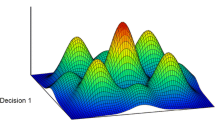Abstract
Linkages between complex adaptive systems (CAS) thinking and efficiency analysis are in their infancy. This paper associates the basic building blocks of the CAS “flocking” metaphor with the essential building blocks of the data envelopment analysis (DEA) form of productive efficiency analysis. The linkage between these paradigms is made within an agent-based modeling framework we have named the complex adaptive productive efficiency model. Within this framework DEA “decision-making units” (DMUs) representing business units within a management system, are modeled as agents and are therefore known as agent DMU’s (ADMUs). Guided by the three fundamental rules inherent in the flocking metaphor, ADMUs “align” with other ADMUs to achieve mutual protection and reduce risks. They “cohere” with the most efficient ADMUs among them to achieve the greatest possible efficiency in the least possible time. And they “separate” themselves for one another just enough to maintain diversity of operations and avoid unnecessary competition among business units of the management system. Analysis of the resulting patterns of ADMU behavior over time enable policy insights measured against benchmarks of productive efficiency that are both intuitive and evidence-based.





Similar content being viewed by others
References
Andrus, D. C. (2005). The wiki and the blog: Toward a complex adaptive intelligence community. Social Science Network, 49(3), 9.
Banker, R. D., Charnes, A., & Cooper, W. W. (1984). Some models for estimating technical and scale inefficiencies in data envelopment analysis. Management Science, 30(9), 1078–1092.
Chorn, N. (1991). Alignment theory: Creating strategic fit. Management Decision, 29(1), 20–24. http://www.emeraldinsight.com/action/doSearch?ContribStored=Chorn%2C+N+H.
Cobb, C. W., & Douglas, P. H. (1928). A theory of production. American Economic Review, 18(Supplement), 139–165.
Cooper, W. W., Seiford, L. M., & Tone, K. (2007). Data envelopment analysis: A comprehensive text with models, applications, references and DEA-solver software (2nd ed.). London: Kluwer.
Dougherty, F. (2014). Complex adaptive systems approach for productive efficiency analysis. Ph.D. dissertation, Virginia Tech.
Dougherty, F., Ambler, N., & Triantis, K. P. (2015). A complex adaptive systems approach to the analysis of productive efficiency: Formulations. Working paper, Virginia Tech, System Performance Lab.
Fisher, L. (2009). The perfect swarm: The science of complexity in everyday life. New York, NY: Basic Books.
Farrell, M. J. (1957). The measurement of productive efficiency. Journal of the Royal Statistical Society, Series A (General), 120(3), 253–290.
Gilbert, N. (2008). Agent-based models. London: Sage.
Holland, J. H. (1995). Hidden order: How adaptation builds complexity. New York, NY: Perseus.
Holland, J. H. (1999). Emergence: From chaos to order. New York, NY: Perseus.
Jadbabaie, A., Lin, J., & Morse, A. S. (2002). Coordination of groups of mobile autonomous agents using nearest neighbor rules. IEEE Transactions on Automatic Control, 48(6), 988–1001.
Johnson, S. (2001). Emergence, the connected lives of ants, brains, cities, and software. New York, NY: Simon and Schuster.
Kaplan, R., & Norton, D. (2004). Strategy maps. Boston, MA: Harvard University Press.
Lewin, R. (1999). Complexity, life at the edge of chaos. Chicago, IL: University of Chicago Press.
Lissack, M., & Letiche, H. (2002). Complexity, emergence, resilience and cohesion gaining perspective on organizations and their study. Emergence, 4(3), 72–94. http://philpapers.org/foundation.
Mar-Molinero, C., Prior, D., Segovia, M., & Portillo, F. (2014). On central resource utilization and its allocation by using DEA. Annals of Operations Research, 221(1), 273–283.
Miller, J. H., & Page, S. E. (2007). Complex adaptive systems, computational models of social life. Princeton, NJ: Princeton University Press.
Reynolds, C. W. (1987). Flocks, herds, and schools: A distributed behavioral model. Computer Graphics, 21(4), 25–34.
Ronald, E. M. A., Sipper, M., & Capcarrere, M. S. (1999). Testing for emergence in artificial life. In D. Floreano, J. D. Nicond, & F. Mondada (Eds.), Proceedings of the fifth European conference on artificial life (ECAL ’99) (pp. 13–20). Heidleberg: Springer.
Rosenhead, J. (1998). Complexity theory and management practice, epistemology of the use & misuse of metaphors from the new sciences. HND—Complexiteitsmanagement. info@ericwil.nl; j.rosenhead@lse.ac.uk, Netherlands.
Rungsuriyawiboon, S., & Stefanou, S. E. (2009). Dynamic efficiency estimation: An application to US electric utilities. Agricultural Economics Review, 10(1), 18–31.
Tanner, H. G., Jadbabaie, A., & Pappas, G. J. (2003). Stable flocking of mobile agents Part II: Dynamic topology. In Proceedings of the 42nd IEEE conference on decision and control (Vol. 2, pp. 2016–2021). Philadelphia, PA: Penn Libraries.
Van De Walle, S., & Hammerschmid, G. (2011). The impact of the new public management: Challenges for coordination and cohesion in European public sectors. Halduskultuur-Adminstartive Culture, 12(2), 190–209.
Vaneman, W., & Triantis, K. P. (2003). The dynamic production axioms and system dynamics behaviors: The foundation for future integration. Journal of Productivity Analysis, 9(1), 93–113.
Vicsek, T., Czirok, A., Ben Jacob, E., Cohen, I., & Schochet, O. (1995). Novel type of phase transitions in a system of self-driven particles. Physical Review Letters, 75, 1226–1229.
Wilensky, U. (1999). NetLogo. Evanston, IL: Center for Connected Learning and Computer-based Modeling, Northwestern University. http://ccl.northwestern.edu/netlog/.
Acknowledgments
This paper is based in part on work supported by the National Science Foundation, while working at the Foundation. Any opinion, finding, and conclusions and recommendations expressed in this paper are those of the authors and do not necessarily reflect the views of the National Science Foundation.
Author information
Authors and Affiliations
Corresponding author
Rights and permissions
About this article
Cite this article
Dougherty, F.L., Ambler, N.P. & Triantis, K.P. A complex adaptive systems approach for productive efficiency analysis: building blocks and associative inferences. Ann Oper Res 250, 45–63 (2017). https://doi.org/10.1007/s10479-016-2134-3
Published:
Issue Date:
DOI: https://doi.org/10.1007/s10479-016-2134-3




